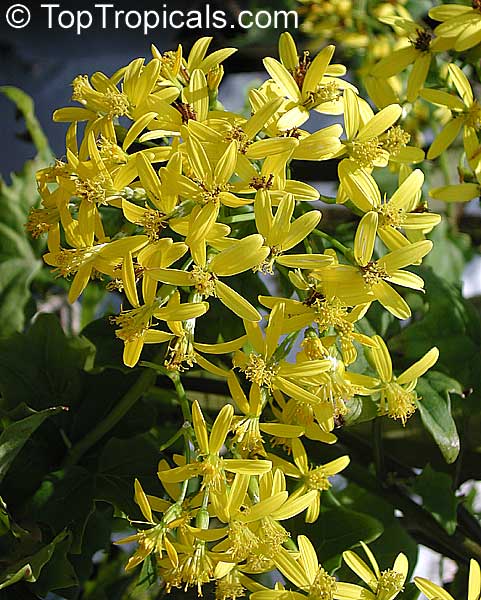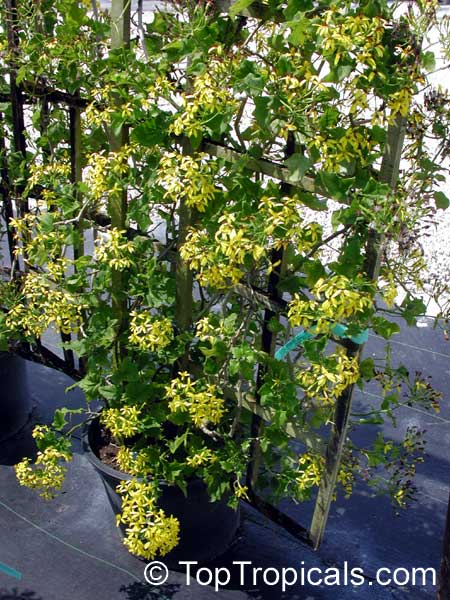TROPICAL PLANT ENCYCLOPEDIA
Senecio mikanioides, Delairea odorataGerman Ivy, Cape Ivy, Water Ivy, Parlor Ivy
Family: Asteraceae
Origin: South Africa









Cape Ivy or German Ivy is considered a groundcover option and a low-growing plant, growing up to 2 feet tall depending on the climate. The plant prefers full sun or semi-shade and requires regular or moderate water. In cooler climates it should be grown in a pot and placed in full sun to help it survive properly. The vibrant yellow and orange flowers attract many hummingbirds and butterflies.
Cape Ivy does thrive in USDA zone 9-11, however, it can become an invasive ground cover for some climates, so it should be monitored. When planting in a garden bed, it is recommended to dig a trench and layer the surface with newspaper to prevent the roots from spreading. Pruning of the stems and flowers is also important to contain the plant's growth and should be done after flowering occurs.
Growth for this plant is normally slow, so fertilizer is not necessary. A layer of leaf mulch in the surrounding area helps retain moisture and suppresses weeds. The plant is tolerant to low temperatures and some frost however frost-tender leaves may discolor and damage if temperatures are too cold.
All in all, Senecio mikanioides or Cape Ivy or German Ivy, is an easy to care for, hardy plant that produces vibrant yellow and orange flowers in the spring. It attracts hummingbirds and butterflies and is suitable for USDA zone 9 through 11 climates when care instructions are followed. Caring for the plant includes regular pruning, as well as preventing the root from spreading by layering the surface with newspaper. Fertilizer is not necessary for this slow-growing plant and leaf mulch should be used to retain moisture and suppress weeds.
Similar plants:
- Curio articulatus, Senecio articulatus, Kleinia articulata (Hot Dog Cactus, Candle Plant)
- Curio herreanus, Senecio herreianus (Gooseberry, String of Beads)
- Curio rowleyanus, Senecio rowleyanus (String of pearls, String of peas, Bead Plant)
- Curio x peregrinus, Senecio x peregrinus (Dolphin Necklace, Flying Dolphins, Senecio Hippogriff)
- Kleinia neriifolia, Senecio kleinia (Verode)
- Kleinia pendula, Senecio pendulus (Tapeworm Plant)
- Kleinia stapeliiformis, Senecio stapeliiformis (Pickle Plant)
- Pericallis x hybrida, Senecio cruentus, Senecio x hybrida (Florist's Cineraria)
- Pseudogynoxys chenopodioides, Senecio confusus (Mexican Flame Vine, Orangeglow Vine)
- Roldana petasitis, Senecio petasitis (Velvet Groundsel, California Geranium)




